The Role of Helicobacter pylori in Gastrointestinal Health: Difference between revisions
| (14 intermediate revisions by the same user not shown) | |||
| Line 3: | Line 3: | ||
[[Image:Gutmicrobiome.webp|thumb|300px|left|The gut microbiome contains millions of microbes essential to the health of humans. Photo credit: [https://news.harvard.edu/gazette/story/2021/05/study-links-genetic-makeup-of-bacteria-in-the-human-gut-to-several-diseases/ Harvard Gazette]]] | [[Image:Gutmicrobiome.webp|thumb|300px|left|The gut microbiome contains millions of microbes essential to the health of humans. Photo credit: [https://news.harvard.edu/gazette/story/2021/05/study-links-genetic-makeup-of-bacteria-in-the-human-gut-to-several-diseases/ Harvard Gazette]]] | ||
The human gut microbiome is a critical indicator of a person's health because of its profound influence on physiological processes. The number of bacterial cells outnumbers the number of human cells in the gut microbiota, and these microbes play large roles in metabolism and immune function to keep the body alive.<ref>Bull MJ. (2014). Part 1: The Human Gut Microbiome in Health and Disease. <i>Integr Med (Encinitas)<i>, 13(6):17-22. From PMC4566439</ref> | The human gut microbiome is a critical indicator of a person's health because of its profound influence on physiological processes. The number of bacterial cells outnumbers the number of human cells in the gut microbiota, and these microbes play large roles in metabolism and immune function to keep the body alive.<ref>Bull MJ. (2014). Part 1: The Human Gut Microbiome in Health and Disease. <i>Integr Med (Encinitas)<i>, 13(6):17-22. From PMC4566439</ref> | ||
<br> | <br> | ||
<br> | |||
The gut microbiome also serves as a barrier against pathogens, preventing their colonization and mitigating the risk of infections. However, when the delicate balance of microorganisms in the gut is disturbed, it compromises this protective barrier, leaving us more vulnerable to harmful invaders and the potential onset of gastrointestinal infections.<ref>Bull MJ. (2014). Part 1: The Human Gut Microbiome in Health and Disease. <i>Integr Med (Encinitas)</i>, 13(6):17-22. From PMC4566439</ref> | |||
<br> | |||
<br> | |||
For a long time, prior to the 19th century, the stomach was believed to be a sterile and bacteria free environment. However, by the late 19th and early 20th centuries, research has reported observing spiral microorganisms in the gut of both animals and humans, this was especially prevalent in individuals who were considered to have gastric diseases and infections like peptic ulcers and gastric cancer. Despite these observations, the significance of these spiral shaped microorganisms could not be fully understood at the time and was often dismissed as bacterial overgrowth and/or food contaminants. <ref>Kusters JG, van Vliet AH, Kuipers EJ. (2006). Pathogenesis of Helicobacter pylori infection. <i>Clin Microbiol Rev. </i> From PMC1539101 </ref> | For a long time, prior to the 19th century, the stomach was believed to be a sterile and bacteria free environment. However, by the late 19th and early 20th centuries, research has reported observing spiral microorganisms in the gut of both animals and humans, this was especially prevalent in individuals who were considered to have gastric diseases and infections like peptic ulcers and gastric cancer. Despite these observations, the significance of these spiral shaped microorganisms could not be fully understood at the time and was often dismissed as bacterial overgrowth and/or food contaminants. <ref>Kusters JG, van Vliet AH, Kuipers EJ. (2006). Pathogenesis of Helicobacter pylori infection. <i>Clin Microbiol Rev. </i> From PMC1539101 </ref> | ||
In the early 1980s, Australian researchers, Barry Marshall and Robbin Warren set out to discover this spiral shaped microorganism that was prevalent in gut diseases and infections. They successfully isolated and cultured a sprial shaped bacterium from human gastric biopsy samples. This bacteria had been classified to be “Campylobacter-like organisms”, and had no real identified name. These bacteria were eventually classified as <i>Helicobacter pylori</i> and were indeed found to be directly linked with those who had gastritis and peptic ulcers. <ref>Kusters JG, van Vliet AH, Kuipers EJ. (2006). Pathogenesis of <i>Helicobacter pylori</i> infection. <i>Clin Microbiol Rev. </i> From PMC1539101 </ref> | In the early 1980s, Australian researchers, Barry Marshall and Robbin Warren set out to discover this spiral shaped microorganism that was prevalent in gut diseases and infections. They successfully isolated and cultured a sprial shaped bacterium from human gastric biopsy samples. This bacteria had been classified to be “Campylobacter-like organisms”, and had no real identified name. These bacteria were eventually classified as <i>Helicobacter pylori</i> and were indeed found to be directly linked with those who had gastritis and peptic ulcers. <ref>Kusters JG, van Vliet AH, Kuipers EJ. (2006). Pathogenesis of <i>Helicobacter pylori</i> infection. <i>Clin Microbiol Rev. </i> From PMC1539101 </ref> | ||
| Line 13: | Line 15: | ||
<br><i>Helicobacter pylori</i> is a gram-negative, flagella-bearing spiral-shaped epsilonproteobacterium that can grow in extremely acidic environments, like the stomach where it invades the host. Its "<i>Helico-</i>" name derives from its helical body and because of its shape, the bacteria can make its way through the viscous lining of the stomach with help from stomach enzymes. However, once <i>H. pylori</i> gets colonized in the stomach, its shape can convert from the rod shape to an inactive coccoid shape.<ref>Salama NR. (2020). Cell morphology as a virulence determinant: lessons from <i>Helicobacter pylori</i>. <i>Curr Opin Microbiol</i>54:11-17. From 10.1016/j.mib.2019.12.002.</ref> | <br><i>Helicobacter pylori</i> is a gram-negative, flagella-bearing spiral-shaped epsilonproteobacterium that can grow in extremely acidic environments, like the stomach where it invades the host. Its "<i>Helico-</i>" name derives from its helical body and because of its shape, the bacteria can make its way through the viscous lining of the stomach with help from stomach enzymes. However, once <i>H. pylori</i> gets colonized in the stomach, its shape can convert from the rod shape to an inactive coccoid shape.<ref>Salama NR. (2020). Cell morphology as a virulence determinant: lessons from <i>Helicobacter pylori</i>. <i>Curr Opin Microbiol</i>54:11-17. From 10.1016/j.mib.2019.12.002.</ref> | ||
<br><i>Helicobacter pylori</i> is a class 1 carcinogenic bacteria, 1 being named the most carcinogenic a microbe can be and 4 being | <br><i>Helicobacter pylori</i> is a class 1 carcinogenic bacteria, 1 being named the most carcinogenic a microbe can be and 4 being not cancerous at all. <i>H. pylori</i> was determined to be a class 1 carcinogen more than 30 years ago from purely epidemiological data. This investigation showed a positive relationship between gastritis cancer and <i>H. pylori</i>. A couple of years after this phenomenon, in 1991, further evidence showed the prevalence of <i>H. pylori</i> antibodies in patients with gastric and bowel cancer.<ref>Asaka M., et al. (2001).<i>Helicobacter pylori</i>: Physiology and Genetics. Ch. 40. <i>ASM Press</i> From https://www.ncbi.nlm.nih.gov/books/NBK2445/</ref> | ||
[[Image:Helicobacteringut.png|thumb|300px|left|<i>Helicobacter pylori</i> colonizes in the gastric epithelium and can proliferate. Photo credit: [https://nerd.wwnorton.com/nerd/229559/r/goto/cfi/54!/4/ Slonczewski et al., Microbiology An Evolving Science]]] | [[Image:Helicobacteringut.png|thumb|300px|left|<i>Helicobacter pylori</i> colonizes in the gastric epithelium and can proliferate. Photo credit: [https://nerd.wwnorton.com/nerd/229559/r/goto/cfi/54!/4/ Slonczewski et al., Microbiology An Evolving Science]]] | ||
| Line 21: | Line 23: | ||
==<b>Who is at risk? </b>== | ==<b>Who is at risk? </b>== | ||
<i>Helicobacter pylori</i> is spread in a horizontal gene transfer mechanism, this means the bacteria is spread from one person to another, it is not necessarily genetically inherited but can be spread within families. Typically, <i>H. pylori</i> is spread through direct contact with saliva, vomit, or stool from an infected individual. <ref> Schwarz S, Morelli G, Kusecek B, Manica A, Balloux F, Owen RJ, Graham DY, van der Merwe S, Achtman M, Suerbaum S. (2008). Horizontal versus familial transmission of Helicobacter pylori. <i> PLoS Pathog. </i> From PMC2563686 </ref> | |||
Research also shows that dietary factors contribute to the prevalence of this infection. Factors such as consumption of meat, chili peppers, unfiltered drinking water, and restaurant food put humans at risk<ref>Mhaskar RS, Ricardo I, Azliyati A, Laxminarayan R, Amol B, Santosh W, Boo K. (2013). Assessment of risk factors of <i>Helicobacter pylori<i> infection and peptic ulcer disease. <i>J Glob Infect Dis.<i> From PMC3703212 </ref> as this bacteria can survive in contaminated water and food sources, especially where the pH is ideal at 4.9-6.0.<ref>Zamani M, Vahedi A, Maghdouri Z, Shokri-Shirvani J. (2017). Role of food in environmental transmission of <i>Helicobacter pylori</i>. <i>Caspian J Intern Med.<i> From PMC5596183 </ref> | |||
<br> | |||
<br> | |||
In the United States, age emerges as a significant determinant of <i>H. pylori</i> infection, with over half of infected individuals aged 50 and above. Moreover, disparities in genetics and health further exacerbate the prevalence of the infection among African Americans, with around half of Latin American and Eastern European descent also affected by <i>H. pylori</i>.<ref>Johns Hopkins Medicine. (2023).<i>Helicobacter pylori</i>.<i>Johns Hopkins Medicine.</i>From https://www.hopkinsmedicine.org/health/conditions-and-diseases/helicobacter-pylori | In the United States, age emerges as a significant determinant of <i>H. pylori</i> infection, with over half of infected individuals aged 50 and above. Moreover, disparities in genetics and health further exacerbate the prevalence of the infection among African Americans, with around half of Latin American and Eastern European descent also affected by <i>H. pylori</i>.<ref>Johns Hopkins Medicine. (2023).<i>Helicobacter pylori</i>.<i>Johns Hopkins Medicine.</i>From https://www.hopkinsmedicine.org/health/conditions-and-diseases/helicobacter-pylori | ||
</ref> | </ref> | ||
<br> | |||
[[Image:Stomachlayers.jpg|thumb|300px|right|The epithelial cell layer acts as a chemical barrier from the pathogens that could enter the mucosa and deeper tissue and cause infection. Photo credit: [https://www.shutterstock.com/search/human-stomach-histology/ Shutterstock]]] | [[Image:Stomachlayers.jpg|thumb|300px|right|The epithelial cell layer acts as a chemical barrier from the pathogens that could enter the mucosa and deeper tissue and cause infection. Photo credit: [https://www.shutterstock.com/search/human-stomach-histology/ Shutterstock]]] | ||
The risk of <i>H. pylori</i> infection significantly increases when combined with aspirin, non-steroidal anti-inflammatory drugs (NSAIDs), and/or frequent steroid use. These medications compromise the stomach's epithelial barrier, creating a more favorable environment conducive to <i>H. pylori</i> colonization and persistence. Once the bacteria breach this barrier and infiltrate the gastric mucosa, the risk of developing complications like ulcers and long-term gastric cancer escalates.<ref>Abadi AT, Ierardi E, Lee YY. (2015). Why do we still have <i>Helicobacter pylori.<i> in our Stomachs.<i>Malays J Med Sci.<i> From PMCID: PMC5295741 </ref> | The risk of <i>H. pylori</i> infection significantly increases when combined with aspirin, non-steroidal anti-inflammatory drugs (NSAIDs), and/or frequent steroid use. These medications compromise the stomach's epithelial barrier, creating a more favorable environment conducive to <i>H. pylori</i> colonization and persistence. Once the bacteria breach this barrier and infiltrate the gastric mucosa, the risk of developing complications like ulcers and long-term gastric cancer escalates.<ref>Abadi AT, Ierardi E, Lee YY. (2015). Why do we still have <i>Helicobacter pylori.<i> in our Stomachs.<i>Malays J Med Sci.<i> From PMCID: PMC5295741 </ref> | ||
<br> | <br> | ||
<br> | <br> | ||
<br> | <br> | ||
<br> | <br> | ||
| Line 58: | Line 62: | ||
==<b>Symptoms and Detection of <i>Helicobacter pylori</i> Infection</b>== | ==<b>Symptoms and Detection of <i>Helicobacter pylori</i> Infection</b>== | ||
The first internal sign of gastritis is the formation of a peptic ulcer in the stomach or the duodenum area, the small intestine of the stomach. Peptic ulcers often cause symptoms of indigestion and this can be coupled with pain and discomfort in areas between the belly button and breastbone, this pain is the most common symptom of peptic ulcers. Other related symptoms are: feeling full too soon while eating, nausea, vomiting, bloating, and belching. However, these symptoms are no means of direct correlation between the two. <ref>U.S. Department of Health and Human Services. (2022). Symptoms & causes of peptic ulcers (stomach or duodenal ulcers) <i>National Institute of Diabetes and Digestive and Kidney Diseases.</i> From https://www.niddk.nih.gov/health-information/digestive-diseases/peptic-ulcers-stomach-ulcers/symptoms-causes | The first internal sign of gastritis is the formation of a peptic ulcer in the stomach or the duodenum area, the small intestine of the stomach. Peptic ulcers often cause symptoms of indigestion and this can be coupled with pain and discomfort in areas between the belly button and breastbone, this pain is the most common symptom of peptic ulcers. Other related symptoms are: feeling full too soon while eating, nausea, vomiting, bloating, and belching. However, these symptoms are no means of direct correlation between the two. <ref>U.S. Department of Health and Human Services. (2022). Symptoms & causes of peptic ulcers (stomach or duodenal ulcers) <i>National Institute of Diabetes and Digestive and Kidney Diseases.</i> From https://www.niddk.nih.gov/health-information/digestive-diseases/peptic-ulcers-stomach-ulcers/symptoms-causes | ||
</ref> | </ref> | ||
Latest revision as of 00:31, 15 April 2024
Human Gut Microbiome and Helicobacter pylori's Presence
By Alexis Newman
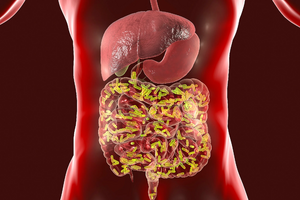
The human gut microbiome is a critical indicator of a person's health because of its profound influence on physiological processes. The number of bacterial cells outnumbers the number of human cells in the gut microbiota, and these microbes play large roles in metabolism and immune function to keep the body alive.[1]
The gut microbiome also serves as a barrier against pathogens, preventing their colonization and mitigating the risk of infections. However, when the delicate balance of microorganisms in the gut is disturbed, it compromises this protective barrier, leaving us more vulnerable to harmful invaders and the potential onset of gastrointestinal infections.[2]
For a long time, prior to the 19th century, the stomach was believed to be a sterile and bacteria free environment. However, by the late 19th and early 20th centuries, research has reported observing spiral microorganisms in the gut of both animals and humans, this was especially prevalent in individuals who were considered to have gastric diseases and infections like peptic ulcers and gastric cancer. Despite these observations, the significance of these spiral shaped microorganisms could not be fully understood at the time and was often dismissed as bacterial overgrowth and/or food contaminants. [3]
In the early 1980s, Australian researchers, Barry Marshall and Robbin Warren set out to discover this spiral shaped microorganism that was prevalent in gut diseases and infections. They successfully isolated and cultured a sprial shaped bacterium from human gastric biopsy samples. This bacteria had been classified to be “Campylobacter-like organisms”, and had no real identified name. These bacteria were eventually classified as Helicobacter pylori and were indeed found to be directly linked with those who had gastritis and peptic ulcers. [4]
To demonstrate the role of H. pylori in gastric diseases, Marshall and Warren conducted a risky self-ingestion experiment where Marshall consumed the culture of the bacteria. This experiment resulted in transient gastritis, providing compelling evidence of the bacterium’s pathogenicity. The next experiments included additional subjects to volunteer and further support these findings to conclude that H. pylori colonization could induce inflammation of the gastric mucosa. [5]
The discovery of Helicobacter pylori challenged the previous standing medical dogma and revolutionized our understanding of gastric diseases. This became increasingly evident in the relationship between H. pylori infection directly causes various upper gastrointestinal disorders. Marshall and Warren won the Nobel Prize in Physiology and Medicine in 2005 because of their groundbreaking discovery ofH. pylori and its role in the gut microbiome.[6]
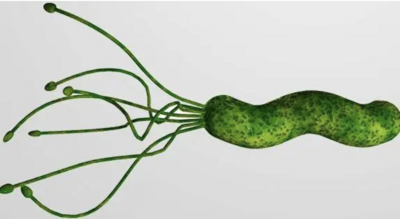
Helicobacter pylori is a gram-negative, flagella-bearing spiral-shaped epsilonproteobacterium that can grow in extremely acidic environments, like the stomach where it invades the host. Its "Helico-" name derives from its helical body and because of its shape, the bacteria can make its way through the viscous lining of the stomach with help from stomach enzymes. However, once H. pylori gets colonized in the stomach, its shape can convert from the rod shape to an inactive coccoid shape.[7]
Helicobacter pylori is a class 1 carcinogenic bacteria, 1 being named the most carcinogenic a microbe can be and 4 being not cancerous at all. H. pylori was determined to be a class 1 carcinogen more than 30 years ago from purely epidemiological data. This investigation showed a positive relationship between gastritis cancer and H. pylori. A couple of years after this phenomenon, in 1991, further evidence showed the prevalence of H. pylori antibodies in patients with gastric and bowel cancer.[8]
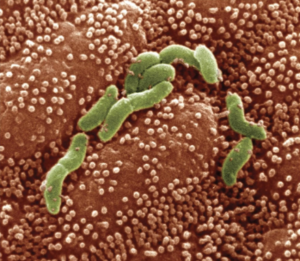
Interstingly, H. pylori prevalence is not a problem for all hosts, in fact, some people will go their whole lives with no effects.[9]However, for the 20 - 30% of people who are infected, the consequences can be life-threatening: gastritis (stomach cancer), peptic ulcers, and gastric mucosa-associated lymphoid tissue (MALT) lymphoma. Investigation reports state that at least 7 million cases of these listed diseases happen annually, worldwide.[10]
Who is at risk?
Helicobacter pylori is spread in a horizontal gene transfer mechanism, this means the bacteria is spread from one person to another, it is not necessarily genetically inherited but can be spread within families. Typically, H. pylori is spread through direct contact with saliva, vomit, or stool from an infected individual. [11]
Research also shows that dietary factors contribute to the prevalence of this infection. Factors such as consumption of meat, chili peppers, unfiltered drinking water, and restaurant food put humans at risk[12] as this bacteria can survive in contaminated water and food sources, especially where the pH is ideal at 4.9-6.0.[13]
In the United States, age emerges as a significant determinant of H. pylori infection, with over half of infected individuals aged 50 and above. Moreover, disparities in genetics and health further exacerbate the prevalence of the infection among African Americans, with around half of Latin American and Eastern European descent also affected by H. pylori.[14]
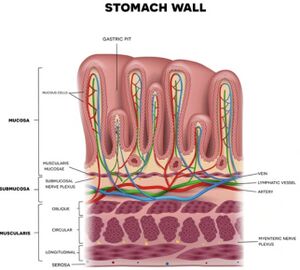
The risk of H. pylori infection significantly increases when combined with aspirin, non-steroidal anti-inflammatory drugs (NSAIDs), and/or frequent steroid use. These medications compromise the stomach's epithelial barrier, creating a more favorable environment conducive to H. pylori colonization and persistence. Once the bacteria breach this barrier and infiltrate the gastric mucosa, the risk of developing complications like ulcers and long-term gastric cancer escalates.[15]
Life Cycle and Survival Mechanisms of Helicobacter pylori
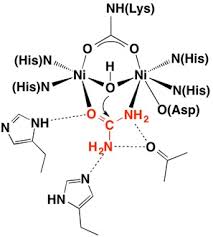
Once H. pylori makes its way into the host successfully, for it to survive and colonize the bacteria needs the means to survive in the highly acidic environment of the stomach. H. pylori secretes urease to neutralize the acidic condition and allow the bacteria to persist in the stomach.[16] The production of urease catalyzes the hydrolysis of urea into ammonia and carbon dioxide. Ammonia acts as a base to neutralize the surrounding pH of the bacteria's space. The neutralizing of this barrier allows H. pylori to use its flagella-mediated motility to adhere to epithelial cells and begin to colonize and infect the host.[17]
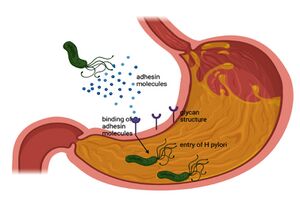
The attachment mechanisms are facilitated by the bacterial adhesions to very specific host cell receptors such as glycan receptors (BabA and SabA), membrane protein (HopZ), the specific luminal side of gastric epithelial cells (CD74), and Decay Accelerating Factor (DAF and CD55) receptors. Additionally, H. pylori can bind to sulfated molecules like herapan sulfate found on the surface of the epithelium. [18]
This immune response results in a congregation of neutrophils along with macrophages and lymphocytes all in an effort to rid the pathogen's survival and infection; however, this often does more harm than good to the host. The build-up of these immune cells causes tissue damage that creates gastric ulcers and/or more severe gastrointestinal infections.[19]
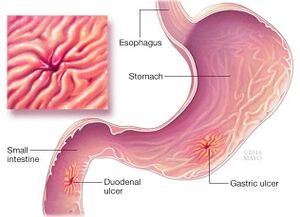
As mentioned previously, Helicobacter pylori is a successful pathogen that has colonized more than half of the human population. A valid question some might ask is how this pathogen does not infect everyone, while some immune response mechanisms do work effectively, H. pylori has evolved to overcome the host defense mechanisms.
Firstly, H. pylori has modified its surface, lipopolysaccharide, and flagellin to evade detection by host pattern recognition receptors, for example, the tolllike receptors. This makes the bacteria mimic the host structure and ultimately avoids triggering the host's immune system. [20]
H. pylori also avoids phagocytic death by killing the macrophage before it can commit phagocytosis uptake. H. pylori does this by resisting fusion and disrupting the production of reactive oxygen species and nitric oxide from phagocytes making the bacteria free from phagocytic death and survival within the host. [21]
Another way H. pylori has adapted and evolved to thrive and overcome the host's defensive mechanisms is in the induction of apoptosis in gastric epithelial cells. In processes like upregulating the apoptotic pathways, this allows for increased permeability of the gastric mucosa and facilitate the entry of the bacteria into the underlying tissue. This specific path means that the bacteria is secreting its toxic enzymes into the body and degrading tissue. This tissue degradation can be short-lived, acute, and resolved to be only a peptic ulcer. Should this inflammation persist over long periods and continue to degrade the mucosa tissue, gastritis is in full effect. [22]
Symptoms and Detection of Helicobacter pylori Infection
The first internal sign of gastritis is the formation of a peptic ulcer in the stomach or the duodenum area, the small intestine of the stomach. Peptic ulcers often cause symptoms of indigestion and this can be coupled with pain and discomfort in areas between the belly button and breastbone, this pain is the most common symptom of peptic ulcers. Other related symptoms are: feeling full too soon while eating, nausea, vomiting, bloating, and belching. However, these symptoms are no means of direct correlation between the two. [23]
Escalated symptoms that differ from other infections such as black or tarry stool or red and morron blood mixed with stool, red blood in vomit that looks like coffee grounds, sudden or sharp abdominal pain, and dizziness could be caused by H. pylori. These symptoms are obvious signs of peptic ulcers and should be brought to professional attention immediately to obscure the infection. [24]
Gastritis is the escalated scale of inflammation as it is the chronic and persistent degradation of tissue in the stomach lining. This has the more severe and long-lasting symptoms listed above, with the addition of weight loss and loss of appetite. [25]
With the evolution of science, there are now two frequently run stool tests employed to determine if Helicobacter pylori has infected the human body. The first is a stool antigen test, which looks through the stool for the antigens that are associated with H. pylori infection. The second is a stool PCR test. This test is especially useful to determine if there are mutations that could identify the presence of the pathogen as well as if the pathogen has mutations that might be antibiotic-resistant to prescriptions. [26]
Other tests like breath test can be used to quantify the release of carbon dioxide from the body. This test is effective because if H. pylori has colonized, the pill that is swallowed for the test can tag carbon molecules that were in contact with the bacteria and detected by special devices. This is incredibly useful for younger children who are unable to cooperate with a scope screening. Some professionals opt for a scope test that uses a tiny camera on a flexible tube, an endoscope, which can move from the throat to the duodenum to manually and visually search for the infection. [27]
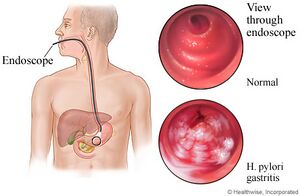
Antibitoics and Remedies
A common first antibiotic used to treat Helicobacter pylori infection is Clarithromycin. Clarithromycin is a macrolide antibiotic that inhibits protein synthesis of bacteria. This antibiotic is usually coupled with amoxicillin and a proton pump inhibitor in a three-way remedy system found to be effective. [28]
Each of these three works in specific cell mechanisms, for example, Clatirhtomycin binds to the bacterial ribosome of the 50s ribosomal subunit and prevents further elongation of the peptide chain during protein synthesis, which induces cell death of growing H. pylori. This effectively interferes with the growth and replication of the bacteria and reduces the load in the stomach of the host. [29]
Amoxicillin is a very common bacterial antibiotic used and is effective because it disrupts the integrity of any bacteria cell wall. Amoxicillin binds to the penicillin-binding proteins (PBPs) that are involved in the linking of peptidoglycan chains from the bacterial cell wall to the epithelial cells. This antibiotic effectively targets the bacteria cells that survive the Calrithomycin, to prevent them from binding to the host cells. [30]
The last part of this three-way remedy is a proton pump inhibitor (PPI), such as Vomoprazan. The gastric epithelium contains a proton pump on the membrane of the stomach lining that is responsible for secreting acid into the stomach lumen to maintain the acidic pH needed for digestion and to keep away pathogens. Interestingly, this inhibition makes the stomach less acidic and in some ways, tricks the bacteria from needing to release its urease and increases the pH to create conditions that are more favorable for the previously mentioned antibiotics. [31]
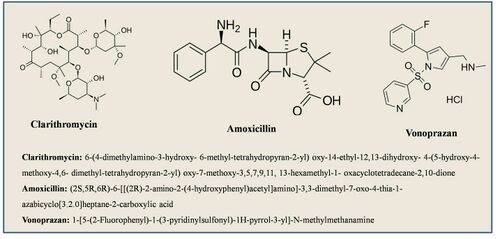
Phytotherapy is a Promising Approach to Treating Helicobacter pylori
Phytotherapy is the use of medicine derived from plants or herbs to treat infections and/or other health conditions, and this method could be a promising approach to treating H. pylori. The extracts from these plants and herbs contain compounds such as flavonoids, terpenoids, coumarins, tannins, and alkaloids which all contain antimicrobial properties. The defense mechanisms of plants are highly researched topic for obtaining new medicine because plants contain a diverse array of bioactive compounds that offer therapeutic effects that the human host does not naturally have. These compounds also are “newer” to bacteria and thus less likely to be antibiotic-resistant to such compounds. [32]

Phytotherapy works by inhibiting H. pylori’s membrane by making it permeabilized and ultimately preventing adhesion to the gastric epithelial cells, these compounds also have been shown to inhibit urease activity. The chemicals of the plant can insert themselves into the lipid layer of the bacteria and cause physical damage to destabilize the membrane structure leading to increased permeability. These compounds can also be used to degrade the cell wall membrane of the bacteria to promote permeability and cell lysis. Plant compounds like flavanoids are incredibly well bound to urease enzymes to inhibit their activity. Flavonoids and alkaloids can interact with the amino acid residue of the active sites of urease and prevent urea from undergoing hydrolysis. [33]
Phytotherapy presents an interesting new repertoire for research for many infections, including Helicobacter pylori. This new method could offer benefits that go further than treatment and look at a wide-scale problem that is antibiotic-resistant genes. Phytochemicals, chemicals from plants, interact with bacterial cells through mechanisms that differ from those targeted by conventional antibiotics. This area of research could change the face of medicine, however, further research is needed to fully understand the potential of physiotherapy in therapeutic strategies.
Conclusion
The complexity of the human gut microbiome and its interaction with pathogens like Helicobacter pylori shows the necessity for a multifaceted understanding of microbial relationships within the human body. While H. pylori does pose significant health risks like gastritis, peptic ulcers, and severe gastric cancer, it’s crucial to recognize that not all individuals are susceptible, or equally susceptible to its effects. Factors such as genetics, age, and environmental influences do play pivotal roles in determining susceptibility to H. pylori infection and its associated complications on the large spectrum of outcomes. Additionally, advancements in detection methods, like stool tests and breath tests, have facilitated more accurate diagnosis, enabling timely interventions to mitigate the progression of H. pylori-related infections. Antibiotic treatments, such as the triple therapy regimen involving Clarithromycin, Amoxicillin, and proton pump inhibitors, have proven effective in managing H. pylori infections; however, the emergence of antibiotic resistance highlights the urgent need for alternative treatment modalities. Phytotherapy, harnessing the therapeutic properties of plant-derived compounds, presents a promising avenue for combating antibiotic-resistant strains of H. pylori and warrants further research. By delving deeper into the mechanisms of microbial pathogenesis and exploring innovative therapeutic approaches, we can better address the challenges posed by pathogens like H. pylori and strive towards improved outcomes for individuals affected by gastrointestinal infections. Ultimately, a comprehensive understanding of host-microbe interactions is essential for advancing preventive states developing targeted therapies, and ultimately safeguarding human health in the face of microbial threats.
References
- ↑ Bull MJ. (2014). Part 1: The Human Gut Microbiome in Health and Disease. Integr Med (Encinitas), 13(6):17-22. From PMC4566439
- ↑ Bull MJ. (2014). Part 1: The Human Gut Microbiome in Health and Disease. Integr Med (Encinitas), 13(6):17-22. From PMC4566439
- ↑ Kusters JG, van Vliet AH, Kuipers EJ. (2006). Pathogenesis of Helicobacter pylori infection. Clin Microbiol Rev. From PMC1539101
- ↑ Kusters JG, van Vliet AH, Kuipers EJ. (2006). Pathogenesis of Helicobacter pylori infection. Clin Microbiol Rev. From PMC1539101
- ↑ Kusters JG, van Vliet AH, Kuipers EJ. (2006). Pathogenesis of Helicobacter pylori infection. Clin Microbiol Rev. From PMC1539101
- ↑ Kusters JG, van Vliet AH, Kuipers EJ. (2006). Pathogenesis of Helicobacter pylori infection. Clin Microbiol Rev. From PMC1539101
- ↑ Salama NR. (2020). Cell morphology as a virulence determinant: lessons from Helicobacter pylori. Curr Opin Microbiol54:11-17. From 10.1016/j.mib.2019.12.002.
- ↑ Asaka M., et al. (2001).Helicobacter pylori: Physiology and Genetics. Ch. 40. ASM Press From https://www.ncbi.nlm.nih.gov/books/NBK2445/
- ↑ Lamont, Thomas. (2024). Patient education: Helicobacter pylori infection and treatment (Beyond the Basics).UptoDate, Inc From https://www.uptodate.com/contents/helicobacter-pylori-infection-and-treatment-beyond-the-basics/print#:~:text=pylori%2C%20is%20a%20bacterium%20that%20causes%20a%20chronic%20infection%20of,and%2C%20rarely%2C%20stomach%20tumors
- ↑ Antonello Covaccie et al., (1999). Helicobacter pylori Virulence and Genetic Geography. Science From 10.1126/science.284.5418.1328
- ↑ Schwarz S, Morelli G, Kusecek B, Manica A, Balloux F, Owen RJ, Graham DY, van der Merwe S, Achtman M, Suerbaum S. (2008). Horizontal versus familial transmission of Helicobacter pylori. PLoS Pathog. From PMC2563686
- ↑ Mhaskar RS, Ricardo I, Azliyati A, Laxminarayan R, Amol B, Santosh W, Boo K. (2013). Assessment of risk factors of Helicobacter pylori infection and peptic ulcer disease. J Glob Infect Dis. From PMC3703212
- ↑ Zamani M, Vahedi A, Maghdouri Z, Shokri-Shirvani J. (2017). Role of food in environmental transmission of Helicobacter pylori. Caspian J Intern Med. From PMC5596183
- ↑ Johns Hopkins Medicine. (2023).Helicobacter pylori.Johns Hopkins Medicine.From https://www.hopkinsmedicine.org/health/conditions-and-diseases/helicobacter-pylori
- ↑ Abadi AT, Ierardi E, Lee YY. (2015). Why do we still have Helicobacter pylori. in our Stomachs.Malays J Med Sci. From PMCID: PMC5295741
- ↑ Kao CY, Sheu BS, Wu JJ. (2016). Helicobacter pylori infection: An overview of bacterial virulence factors and pathogenesis. Biomed J. From PMC6138426
- ↑ Kao CY, Sheu BS, Wu JJ. (2016). Helicobacter pylori infection: An overview of bacterial virulence factors and pathogenesis. Biomed J. From PMC6138426
- ↑ Beswick EJ, Suarez G, Reyes VE. (2006). H pylori and host interactions that influence pathogenesis. World J Gastroenterol.From PMC4088158
- ↑ Kao CY, Sheu BS, Wu JJ. (2016). Helicobacter pylori infection: An overview of bacterial virulence factors and pathogenesis. Biomed J. From PMC6138426
- ↑ Lina TT, Alzahrani S, Gonzalez J, Pinchuk IV, Beswick EJ, Reyes VE. (2014). Immune evasion strategies used by Helicobacter pylori. World J Gastroenterol. World J Gastroenterol. From PMC4177461
- ↑ Lina TT, Alzahrani S, Gonzalez J, Pinchuk IV, Beswick EJ, Reyes VE. (2014). Immune evasion strategies used by Helicobacter pylori. World J Gastroenterol. World J Gastroenterol. From PMC4177461
- ↑ Lina TT, Alzahrani S, Gonzalez J, Pinchuk IV, Beswick EJ, Reyes VE. (2014). Immune evasion strategies used by Helicobacter pylori. World J Gastroenterol. World J Gastroenterol. From PMC4177461
- ↑ U.S. Department of Health and Human Services. (2022). Symptoms & causes of peptic ulcers (stomach or duodenal ulcers) National Institute of Diabetes and Digestive and Kidney Diseases. From https://www.niddk.nih.gov/health-information/digestive-diseases/peptic-ulcers-stomach-ulcers/symptoms-causes
- ↑ U.S. Department of Health and Human Services. (2022). Symptoms & causes of peptic ulcers (stomach or duodenal ulcers) National Institute of Diabetes and Digestive and Kidney Diseases. From https://www.niddk.nih.gov/health-information/digestive-diseases/peptic-ulcers-stomach-ulcers/symptoms-causes
- ↑ Department of Health & Human Services. (2002,). Gastritis. Better Health Channel. From https://www.betterhealth.vic.gov.au/health/conditionsandtreatments/gastritis#causes-of-gastritis
- ↑ Mayo Foundation for Medical Education and Research. (2022). Helicobacter pylori (H. pylori) infection. Mayo Clinic. From https://www.mayoclinic.org/diseases-conditions/h-pylori/diagnosis-treatment/drc-20356177
- ↑ Mayo Foundation for Medical Education and Research. (2022). Helicobacter pylori (H. pylori) infection. Mayo Clinic. From https://www.mayoclinic.org/diseases-conditions/h-pylori/diagnosis-treatment/drc-20356177
- ↑ Kim SY, Choi DJ, Chung JW. (2015). Antibiotic treatment for Helicobacter pylori: Is the end coming? World J Gastrointest Pharmacol Ther. From PMC4635158
- ↑ Kim SY, Choi DJ, Chung JW. (2015). Antibiotic treatment for Helicobacter pylori: Is the end coming? World J Gastrointest Pharmacol Ther. From PMC4635158
- ↑ Kim SY, Choi DJ, Chung JW. (2015). Antibiotic treatment for Helicobacter pylori: Is the end coming? World J Gastrointest Pharmacol Ther. From PMC4635158
- ↑ Kim SY, Choi DJ, Chung JW. (2015). Antibiotic treatment for Helicobacter pylori: Is the end coming? World J Gastrointest Pharmacol Ther. From PMC4635158
- ↑ Liu M, Gao H, Miao J, Zhang Z, Zheng L, Li F, Zhou S, Zhang Z, Li S, Liu H, Sun J. (2024). Helicobacter pylori infection in humans and phytotherapy, probiotics, and emerging therapeutic interventions: a review. Front Microbiol. From PMC10806011
- ↑ Nakonieczna S, Grabarska A, Kukula-Koch W. (2020). The Potential Anticancer Activity of Phytoconstituents against Gastric Cancer-A Review on In Vitro, In Vivo, and Clinical Studies. Int J Mol Sci. From PMC7663924
